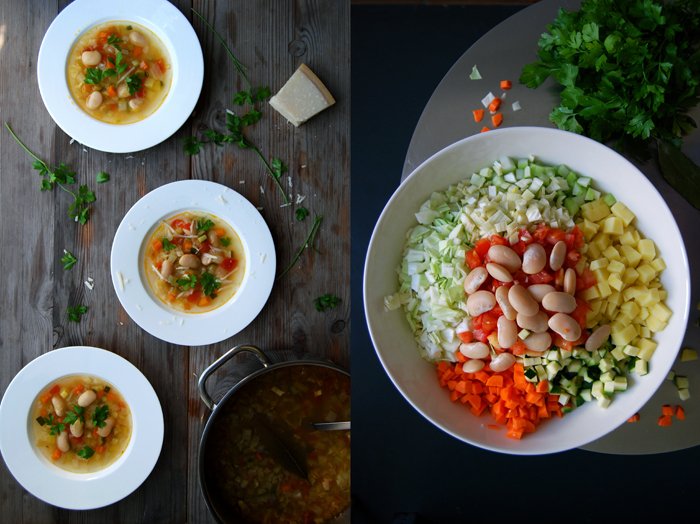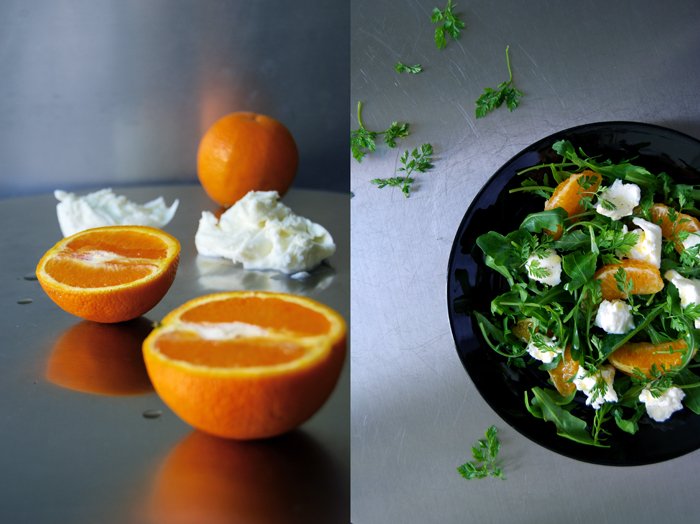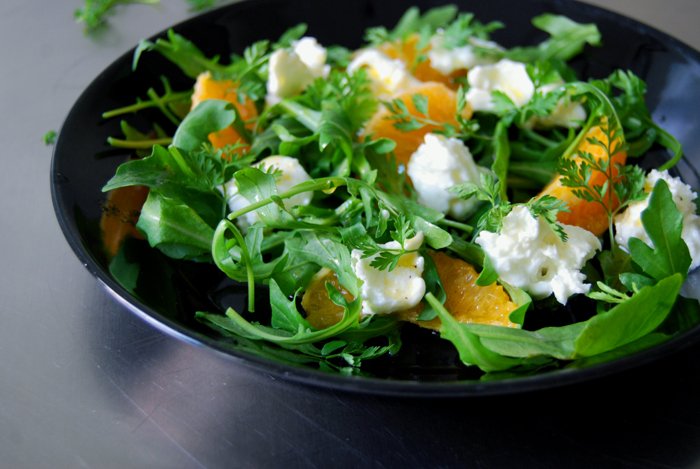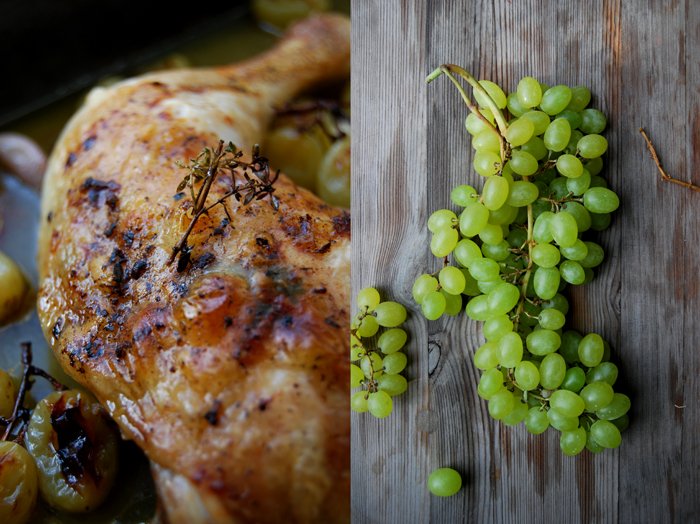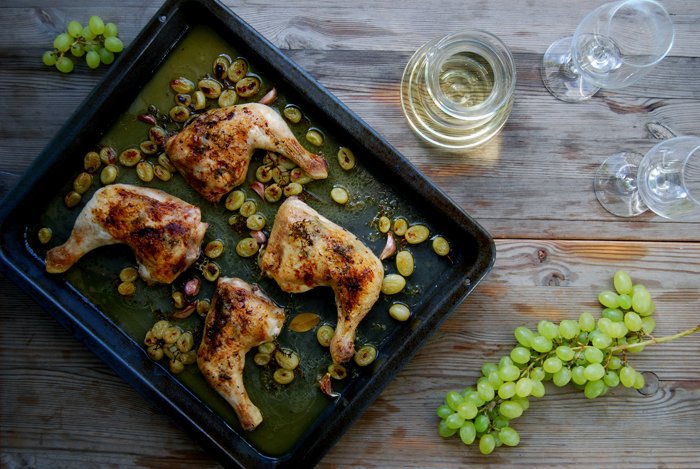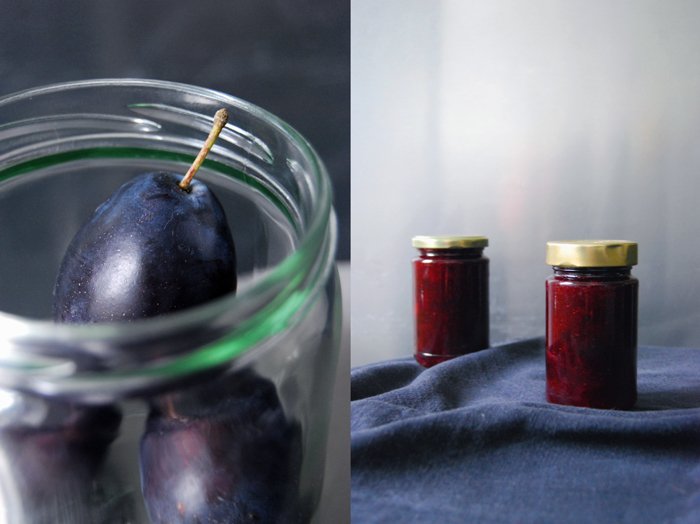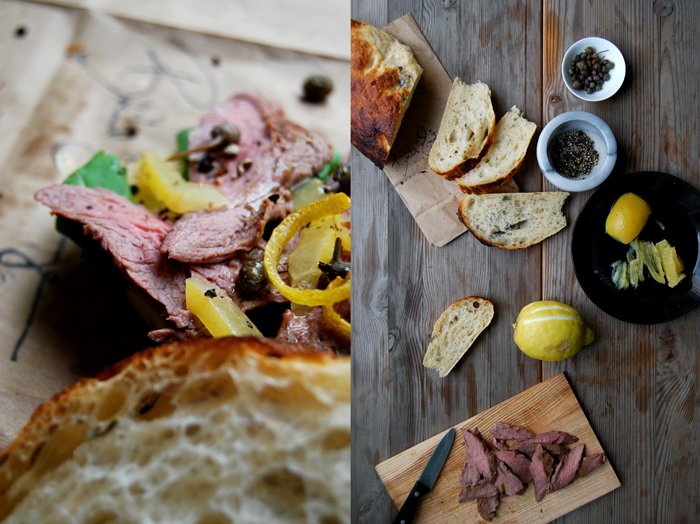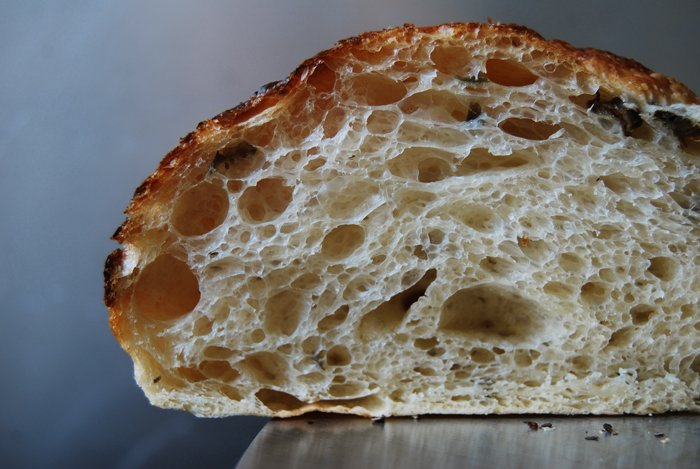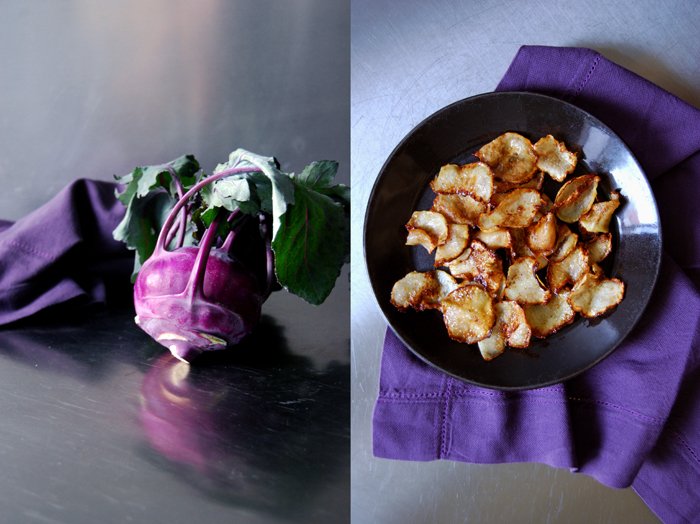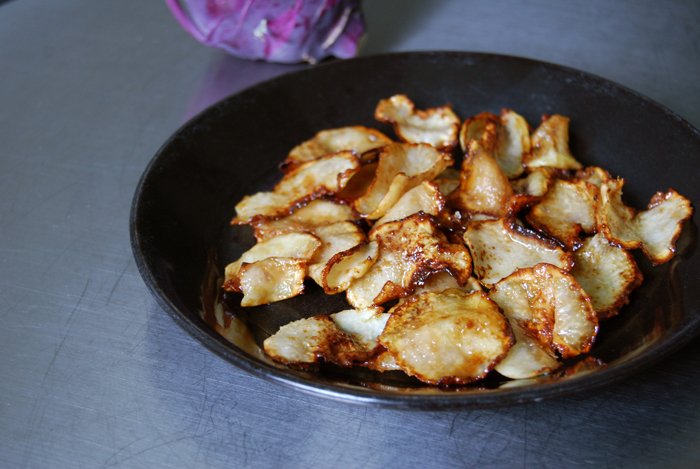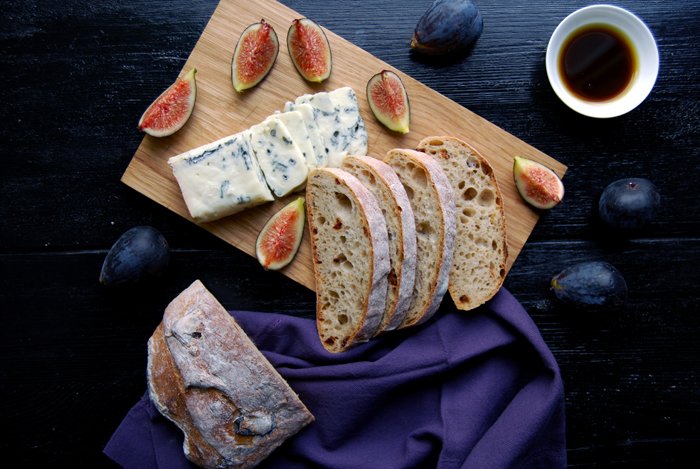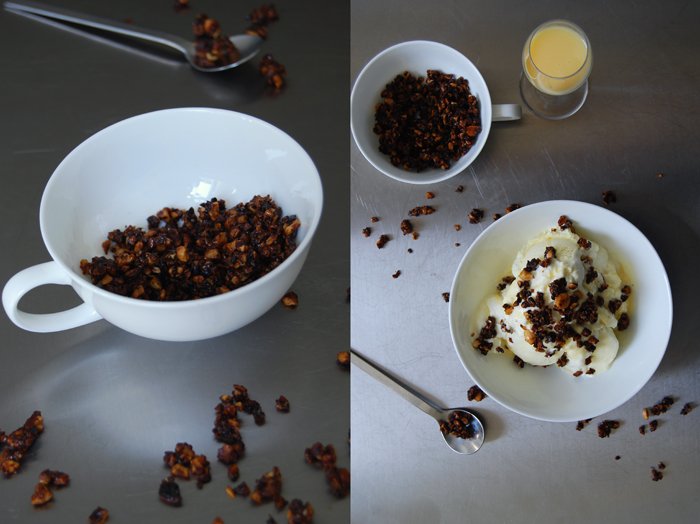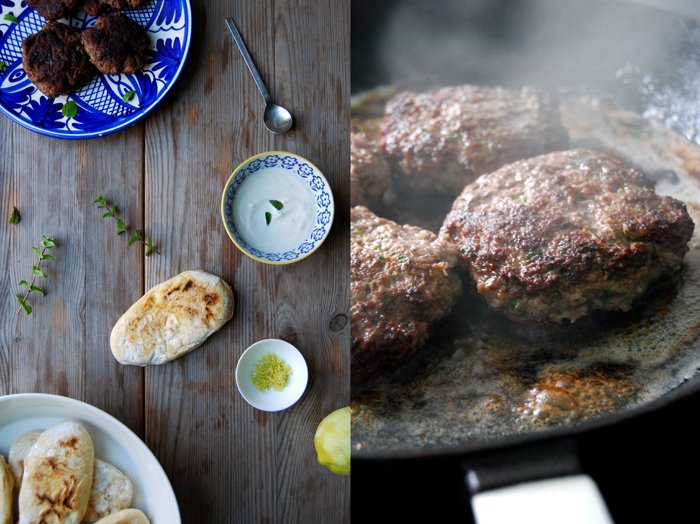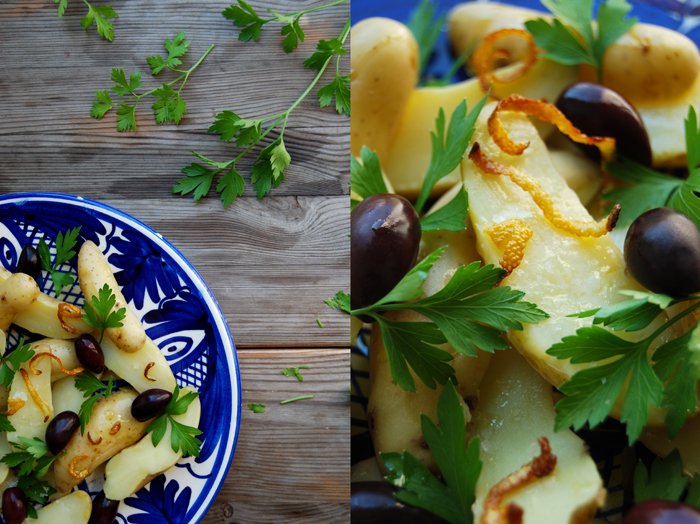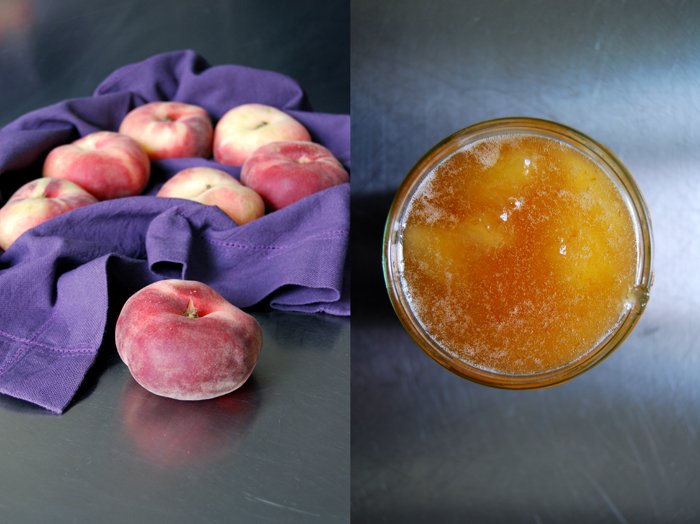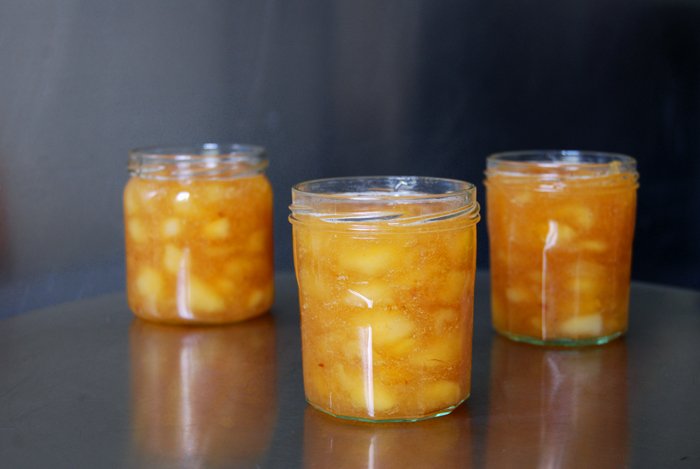Minestrone alla Genovese with Zucchini, Beans and Parmesan
A minestrone simmering on the cooker puts me a into a comfortable mood, the smell and taste reminds me of the kitchens of all the great cooks in my family and it makes me feel at home! I'm very lucky as I'm surrounded by a few women who have mastered the art of a good minestrone.
My Maltese granny Edith cooks her vegetable soup with courgette, marrows and potatoes and I learnt from her that a little parmesan sprinkled on top makes all the difference. The cheese melts into the warming broth and adds a hearty touch to it. My mother goes with the seasons and uses whatever her vegetable garden offers. Beans, cabbage, peas, potatoes, carrots, the list is long and inspiring. She walks through her garden with a big basket in her hand and picks the fruits and vegetables that fit her mood. She taught me to chop everything into small cubes and blanch each vegetable in the broth separately. This way you avoid some vegetables becoming too soggy and soft while others stay crunchy. I don't always do this, sometimes I cook it all at once, it depends on the texture I want to achieve.
My minestrone never tastes the same, I like to try out new variations and this one was inspired by the north of Italy, the Minestrone alla Genovese! This warming soup is so rich in flavours, cooked with cabbage, dried butter beans, zucchini, carrots, potatoes, fennel, tomatoes, celery and leak, I listened to both women to be rewarded with a very satisfying result, I chopped the vegetables into little cubes which would have pleased my mother but I cooked them all at once for not more than 20 minutes. I just cooked the soaked dried butter beans separately as they needed about an hour. After I filled my flavourful soup into the plates, I scattered some parsley leaves and grated Parmesan over it, thanks to Edith!
When I cook minestrone, I cook lots of it as I like to put a few portions in the freezer for a quick lunch or dinner. Once the chopping is done, it just needs another half an hour, so you might as well prepare a bit more. You could also add some little pasta like Anellini or Risini to make the dish a bit richer.
Minestrone alla Genovese
For a large pot of around 4l / 8.5 pints of minestrone (for about 8-12 people) you need
big dried butter beans, soaked over night, 200g / 7 ounces
large onion, chopped, 1
white cabbage, cut into small cubes, 200g / 7 ounces
carrots, cut into small cubes, 150g / 5.5 ounces
zucchini, cut into small cubes, 150g / 5.5 ounces
leek, cut into small cubes, 100g / 3.5 ounces
potatoes, cut into small cubes, 200g / 7 ounces
fennel bulb, cut into small cubes, 100g / 3.5 ounces
large celery stalk, cut into small cubes, 1
large tomatoes, cut into small cubes, 2
broth, hot, 2.8l / 6 pints
garlic, crushed, 3 cloves
bay leaf 1
salt and pepper
olive oil
Parmesan, grated, for the topping
fresh parsley leaves, a handful, for the topping
In a large pot, cook the soaked beans for about an hour or until al dente, drain and set aside.
In a large pot, heat a splash of olive oil and fry the onion for a few minutes on medium heat till golden and soft. Add the garlic and cook for 1 minute. Add a little more oil and the chopped vegetables, stir and cook for 1-2 minutes. Add the hot broth, the beans and bay leaf. Season with salt and pepper and cook for 20 minutes. Season to taste and serve sprinkled with Parmesan and parsley.
Mozzarella di Bufala, Rucola, Orange and Chervil Salad
Mozzarella di Bufala, as creamy as a fresh Burrata, Italian oranges dripping with sweet juices, crunchy rucola (arugula) leaves, delicate chervil (Kerbel in German) and a fruity vinaigrette! This salad is luscious and fresh, a perfect combination of green, fruity and milky flavours.
It's a light culinary break while I'm bustling in my kitchen on the weekend, my little weekly feast when our meals become a bit more lavish and sumptuous. We spend even more time sitting at the table extending our dinners with some cheese, fruit and chutney before we finish it off with dessert. Good food and company, some music, a nice bottle of wine, it's so easy to celebrate those moments when everything feels just right! The end of the week is also my favourite time to bake and to fill the air with the smell of fresh bread, cinnamony cakes and cookies, that's my kind of wellness treat. So, to fully enjoy my numerous kitchen creation, I keep my breakfast and lunch lighter than normally but not necessarily more simple and spartan. I just focus on a few delicate ingredients, like in this salad.
Mozzarella di Bufala, Rucola, Orange and Chervil Salad
For 2-3 people you need
Mozzarella di Bufala, torn into pieces, 125g / 4.5 ounces
orange, peeled and cut into slices, 1
rucola (arugula) leaves, a big handful
chervil (Kerbel), the leaves of a small bunch
olive oil 3 tablespoons
white balsamic vinegar 1 tablespoon
freshly squeezed orange juice 1 1/2 tablespoons
salt and pepper
Whisk the olive oil, vinegar and orange juice and season with salt and pepper to taste.
Arrange the rucola, orange and mozzarella on plates and sprinkle with dressing and chervil.
Moscato Chicken with Grapes and Thyme
A luscious sauce needs time, herbs, spices and wine but sometimes a good 20 minutes in the oven works just as well, when there are chicken legs, Moscato grapes and wine, thyme, bay leaf and garlic on the tray. The meat's roasting juices mix with the sweetness of the fruit and wine and turn into a heavenly rich sauce. We left the roasting pan clean and spotless after we soaked up the last drops with fresh baguette!
This recipe needs lots of garlic! I pushed some thin slices of garlic together with some small sprigs of thyme under the chicken's skin to infuse the meat with their aroma. I also cooked quite a few whole garlic cloves in their skin on the tray which makes a wonderful smooth paste. It tasted so good spread on a slice of bread with a couple roasted grapes and a piece of tender chicken with its crisp skin!
I like to cook with Moscato wine a lot, I use it often in my kitchen as it adds a mellow fruitiness. A Pinot Gris or a Riesling would also be nice for this recipe but it comes down to your personal preference and how much you want to invest in your sauce. Personally, I believe that the wine you use for cooking can easily be more simple than the one you fill into the glasses to accompany your dinner.
Moscato, Grape and Thyme Chicken
For 2-4 people you need
chicken legs 4 (around 1.2kg / 2.5 pounds)
sweet green grapes (like Moscato grapes), on their stalks, 250g / 9 ounces
thyme sprigs, a small handful
garlic, 8 cloves in their skin and 2 cloves cut into very thin slices
fruity white wine (like Moscato) 250ml / 8.5 ounces
small bay leaves 4
olive oil
flaky sea salt
pepper
Set the oven to 200°C / 390°F (I use the Rotitherm setting which works perfectly for poultry).
Spread the chicken legs on a baking dish or tray and push a few thyme sprigs and slices of garlic under the skin of each of them. Rub them on all sides with olive oil and season with sea salt and pepper. Arrange the grapes, garlic cloves and thyme around the meat, put 1 bay leaf under each chicken leg, sprinkle with a splash of olive oil and pour the wine over the meat and fruits.
Cook the chicken legs in the oven for about 20 minutes or until golden brown, pour some of the juices over the meat a couple times while it's cooking. After 20 minutes, check the meat with a skewer, only clear juices should come out. Turn the grill on for a few minutes until the skin starts sizzling and turns dark and crisp. Serve with baguette.
Tyrolean Plum Jam with Cinnamon and Star Anise
This is the kind of jam I would eat for breakfast in the mountains, in an old wooden hut, the morning table strewn with rustic delicacies, thick slices of a hearty loaf of bread, Tyrolean prosciutto, strong cheese, rich butter and this dark jam. It's very fruity and concentrated. The purple fruits cook for around 20 minutes with cinnamon and star anise which gives this thick spread a warm autumn touch (I don't really like to call it wintery yet, it's still too early in the year). The little pieces of the fruits' skin curl up and turn into caramelised fruit bites, delicious!
For my jams, spreads and chutneys, I always try to find the ripest fruits possible, it makes such a difference in taste! Especially when it comes to plums which develop the best side of their strong aromas when they start to soften. Natural sweetness, that's all you need! A hard and sour fruit won't develop its whole range of flavours in a jam.
I call this my Tyrolean Plum Jam as my mountain memories lie in Corvara in the Alta Badia region in South Tyrol. We used to spend many winter holidays in the Italian Dolomite Alps when I was a child, a time of hearty mountain food, aromatic cakes and strudels and some of the best breakfast tables I've ever had!
Tyrolean Plum Jam with Cinnamon and Star Anise
When you cook jam you should always use a tall pot to prevent the jam from boiling over. The fruits will be two to three times as high when they’ve reached boiling point! My pot is 24cm / 9.5″ high and 20cm / 8″ wide.
For 3-4 medium sized jars you need
ripe dark plums (preferably damson plums), pitted and chopped, 1kg/ 2 1/4 pounds
granulated sugar 600g / 1 1/4 pounds
star anise 4 single pieces
ground cinnamon 3 heaping teaspoons or 1 cinnamon stick
Sterilize the jars and lids in boiling water for 5 minutes. Dip the rims of the jars in spirit and wash out the lids, wash the ladle (you will use to fill the jars) with the alcohol as well. If you can get a thick foil for jam jars (thicker than cling film), cut out 3-4 circles roughly the size of the jars and put into the spirit as well.
Put the fruits, sugar and spices in a pot and bring to the boil, stirring with a long wooden spoon every now and then. When the boiling point is reached (you should see quite a few bubbles coming up), let the jam boil for 20 minutes, carefully stirring a couple times (without burning your hand, hence the long spoon!).
Take the pot off the heat and fill the prepared jars with the sterilized ladle almost to the top. Cover with the circles of foil and close tightly immediately. Let the jam sit for a day (or even a month) before you put it on your breakfast table and store the jars in your pantry.
Juicy Lamb, Moroccan Lemon and Caper Sandwich
Maltese capers, dried tomatoes, wild fennel seeds, honey and sea salt, these were just some of the goods I took home with me from my last trip to the Mediterranean island and these were also the ingredients I offered Malin from The Bread Exchange to choose from for our next sandwich. The sourdough queen went for salty capers and then it was my turn to come up with an idea for our next eat in my kitchen x The Bread Exchange creation.
Malin called me in the morning when the bread was done, after a night without much sleep as she had to get up a couple times to take care of her caper sourdough bread. I jumped on my bike excitedly to meet her in her kitchen which was already filled with the sweetest smell of freshly baked bread when I arrived. When she showed me her beautiful loaf of bread, juicy and spongy on the inside as always, refined with capers and the amazing oily crust that Malin mastered to perfection, I couldn't wait to get started in my kitchen! A colourful composition of a few strong flavours, a wave of tastes on the tongue, that was my idea when I held the warm bread in my hands.
This inspiration led to a rich sandwich voluptuously stuffed with tender slices of lamb fillet, cooked for just a few minutes to keep it pink on the inside, thin strips of my Moroccan preserved lemons, crisp lemon peel roasted in olive oil (I used both the infused oil and the rind), salty capers and spicy rucola leaves. This was one of those moments when I wasn't sure if I went a bit overboard with the flavours, especially when they are all so powerful on their own. But the first bite cleared any doubts, there wasn't too much of anything, it was just right!
This sandwich has been featured on Food52!
Lamb, Moroccan Lemon and Caper Sandwich
For 4 sandwiches you need
the best sourdough bread you can get, 8 thick slices
lamb fillet 250g / 9 ounces
Moroccan preserved lemons, cut into thin strips, 1/4
lemon peel, 6 long strips
olive oil 3 tablespoons plus more for frying
capers, rinsed and drained, 1 heaped tablespoon
rucola (arugula) leaves, a small handful
black peppercorns, crushed in a mortar
salt
Set the oven to 200°C / 390°F.
In a small baking dish, mix 3 tablespoons of olive oil with the lemon peel and roast in the oven for 6 minutes or until the lemon is crisp and golden (it shouldn't be brown!). Set the oil and roasted peel aside.
In a heavy pan, heat a splash of olive oil, season the lamb fillet with salt and pepper and brown for 1 1/2 -2 minutes on each side. The meat should stay pink to keep its juiciness. Wrap the fillet in aluminum foil and set aside for a few minutes.
Drizzle a little of the lemon oil on a slice of bread and cover with a few rucola leaves. Cut the lamb fillet into thin slices and spread on top of the greens. Scatter over some strips of Moroccan lemon, roasted lemon peel, capers and lemon oil. Sprinkle with some crushed black pepper and close with another slice of bread.
Here are more eat in my kitchen x The Bread Exchange sandwiches:
Caramelized Kohlrabi Chips
After I stared at this stunning vegetable, a glowing purple kohlrabi, for about five minutes, I could see them right in front of my eyes: sweet, caramelized kohlrabi chips! Thin and sticky with crispy edges!
Normally I buy green kohlrabi as that's what I find at the market most of the time and to be honest, there isn't really a difference in taste, but the deep colour, somewhere between red, blue and the faded green of the leaves makes me grab this one whenever I see it. As soon as it's cut and sliced there isn't much left of its outstanding beauty but that doesn't matter, the taste makes up for it. Especially when the paper thin slices turn into chips which combine the hearty taste of cabbage with the bitter sweetness of caramel.
Caramelized Kohlrabi Chips
For a sweet nibble for 2 you need
kohlrabi, peeled and thinly sliced with a cheese or vegetable slicer, 160g / 5.5 ounces
butter 1 1/2 tablespoons
granulated sugar 1 tablespoon
In a large heavy pan, melt the butter and sugar on a medium-high heat, add the vegetables and spread them flat next to each other. Cook for 2-3 minutes, turn and cook for another minute until golden brown on both sides. Take the chips out and spread them on kitchen roll for just a few seconds. Don't let them cool on the paper or they will stick to it. Nibble cold or warm.
Spinach Ricotta stuffed Conchiglioni on Grilled Cherry Tomatoes
The trilogy of spinach, ricotta and tomatoes is one I use a lot for my pasta dishes, be it in lasagna, ravioli or canneloni. And if I need a really quick dinner I go for conchiglioni, the pretty pasta shells. It's so convenient to stuff these little beauties with all kinds of sauces and vegetables, a thick Bolognese or Ratatouille, mashed pumpkin or a tuna stew, they deliciously carry whatever I choose to fill them with! I also like that I can cook them in advance and just bake them with some cheese under the grill to warm them up, another easy solution for a spontaneous dinner party!
For this recipe I can skip all of the preparations that my classic lasagna requires, no Béchamel, no slow cooked red or meat sauce. I just put a bunch of cherry tomatoes under the grill until their skin starts to burst, it's the same preparation that I used for my orecchiette recipe in July. The roasted fruits are so soft and sweet that I only need to stir in some olive oil, Balsamico vinegar, salt and pepper to turn them into an aromatic and juicy sauce. I spread the conchiglioni on top of the tomatoes in the same dish as soon as they are done, lusciously stuffed with blanched spinach and creamy ricotta and sprinkled with Parmesan. Another 3 minutes under the grill and dinner is served!
Spinach Ricotta stuffed Conchiglioni on Grilled Cherry Tomatoes
For 3-4 people you need
conchiglioni, cooked al dente, around 25 pasta shells
spinach, the hard stems cut off, cleaned, 400g / 14 ounces (mine weighed 600g / 21 ounces before I prepared it)
ricotta 200g / 7 ounces
cherry tomatoes 500g / 1 pound
balsamic vinegar 1 teaspoon
olive oil 2 tablespoons
nutmeg, freshly grated, to taste
salt and pepper
Parmesan, grated, around 40g / 1.5 ounces, for the topping
In a large pot, bring salted water to the boil. Blanche the spinach for 1 minute, rinse with cold water in a colander, drain and squeeze out the water with a spoon. Chop the spinach roughly, mix with the ricotta and season with salt, pepper and nutmeg to taste.
Put the cherry tomatoes in a baking dish (big enough to spread the stuffed conchiglioni on top when the tomatoes are done) and roast the fruits under the grill for 15 minutes or until their skin starts to burst, turn them once or twice. When the tomatoes are done, stir in the balsamic vinegar and olive oil, season with salt and pepper and gently squeeze the tomatoes with a spoon.
Fill the pasta shells with the spinach ricotta stuffing, spread them on top of the tomatoes and push them gently in between the tomatoes. Sprinkle the shells with the Parmesan and some more pepper and put under the grill for around 3 minutes or until the cheese is melted and golden brown. Like with lasagna, it's best to let the dish sit for a few minutes before serving.
A Salad with Greens, Cannellini Beans, Capers and Olives
Some days call for a quick salad and today is one of them, a little snack at noon!
We had a friend over from Costa Rica for a couple nights with her two young kids, so my kitchen creations had to be child friendly. Lasagna, pizza and cake made them very happy (I didn't expect anything else)! We were lucky, summer has come back to the city so we spent many hours out at playgrounds, lots of walking and running around for those little legs which made them hungry all the time!
It was only a short visit but we enjoyed every second of it! Now that they left, the flat is quiet again and I feel like some lighter food. I hadn't made any kitchen plans so I had to work with what I found and inspired me, a big lollo bionda lettuce in the fridge, some parsley on the kitchen window sill, a small can of cannellini beans, my Maltese capers and some black Kalamata olives (this jar is never missing in my pantry). All this thrown together in a large bowl and mixed with a light vinaigrette can make two people very happy. You could also add some canned tuna or tomatoes but I found my Saturday snack perfect as it was.
A Salad with Greens, Cannellini Beans, Capers and Olives
As a lunch for 3 or a side dish for 4 you need
lettuce (lollo bionda or rosso), rinsed, dried and torn into pieces, 1 big head
canned cannelli beans, rinsed and drained, 240g / 8.5 ounces
Kalamata olives 12
capers 4 tablespoons
leaves of a small bunch of parsley
For the dressing
olive oil 3 tablespoons
white balsamic vinegar 2 tablespoons
salt and pepper
Whisk the ingredients for the dressing and season to taste.
In a large bowl, mix the lettuce, beans, olives, capers, parsley and dressing.
Saffron Bouchot Mussels with Tomatoes, Garlic and Parsley
When I have mussels on my cooker I like to add spices, herbs and chopped vegetables, lots of flavours to enrich the broth they're cooking in. I love to dip a piece of fresh baguette into the concentrated juice of wine cooked with mussels, garlic and parsley as much as I like the tender flesh.
The last time I wrote about a recipe with mussels, it was an aromatic bomb inspired by my friend Essa's kitchen. The list of spices was long with turmeric, coriander, fresh and seeds, cayenne pepper, ginger and lemongrass. Not too long after I shared this recipe, Marilena from the Molise region in Italy got in touch with me as she holds a completely different position when it comes to cooking mussels and seafood in general. Pure without too many distractions, that's how it should be cooked in her opinion. I understand her point, and agree partly. I prefer prawn and lobster dishes that focus mainly on the seafood. When it comes to grilled steak fish, I feel the same. That's also one of the reasons why my fish recipes in Malta were quite minimal. Although mussels have a very fine taste of the sea, almost sweet, I find they work very well in combination with exotic aromas. We all have our cooking preferences, our likes and dislikes which makes the product of each kitchen so unique! When it comes to baking, Marilena and I found common ground again. She asked me to bake her Milk Pan di Campobasso, a traditional dolci of the region where she lives. This cake is packed with saffron and Strega (an old Italian saffron liqueur) infused milk and covered with hazelnut icing. I had never heard of this combination before but since then I'm in love with saffron combined with nuts!
Today's recipe for my mussels also works with the strong aroma of this precious, red spice. I felt like a strong broth with a dominant note of saffron mixed with tomatoes, bay leaf, parsley, onions and garlic. The dish looked and tasted like autumn! Warm flavours and colours, red, yellow and green on the shimmering Moules de Bouchot from the Mont-Saint-Michel bay between Brittany and Normandy. The mussels grow on ropes in the sea and that's the taste they bring to the plate, the fresh sea!
Saffron Bouchot Mussels with Tomatoes, Garlic and Parsley
For a lunch for 3-4 people served with baguette you need
mussels in shells (preferably Bouchot mussels) 1 kg / 2 pounds
medium tomatoes, finely chopped, 3
medium onion, finely chopped, 1
garlic, thinly sliced, 3 cloves
white wine 200ml / 7 ounces
bay leaf 1
saffron a pinch
salt 1/2 teaspoon
pepper
olive oil
fresh parsley, roughly chopped, 4 tablespoons plus a few leaves
Rinse and scrub the mussels under cold water and cut off the beard, discard any broken mussels.
In a large pot, heat a splash of olive oil and cook the onion and garlic on a medium heat for a few minutes until soft and golden. Add the tomatoes, bay leaf, wine, saffron, salt, pepper and the mussels. Shake the pot gently to mix or stir with a slotted ladle. Bring to the boil, close with a lid and cook on lowest heat for 5 minutes or until the shells open (shake the pot once or twice while cooking). Discard any mussels that didn't open! Sprinkle the mussels with parsley and serve immediately, in deep plates with a bit of broth and baguette.
Fig and Gorgonzola Ciabatta Sandwich
Late summer figs call for a late summer sandwich, an effortless combination of honey sweet fruit and creamy blue cheese. There's no cooker involved in the preparations, no oven or grill, just 5 ingredients put together in less than 5 minutes and a glass of red wine to go with. This is an early evening sandwich, when you sit outside on your balcony or in the garden, some cheese and prosciutto on the table, a quick salad of rucola thrown together with the last ripe tomatoes from the vine and a light vinaigrette. All you need are some candles, a friend to talk, some music maybe, a glass of dark red wine and this marvelous duo of figs and Gorgonzola.
Figs are one of those fruits that I could eat all year round but, unfortunately, the pleasure of their sweetness, taste and delicateness is limited to only a few summer months. In Malta I pick them off the trees but here, in the city, they are quite a luxurious treat and the quality barely justifies the price. They are never as ripe, soft and tasty as in the Mediterranean, it would be impossible to transport them. So when I spotted a box of organic Italian figs at the market, soft and thin skinned, nothing could stop me. I bought a big handful of them, enough to make a dozen of these late summer sandwiches!
For 6 open tartines, you need a loaf of fresh ciabatta bread, the slices lightly brushed with a dressing of 2 teaspoons of olive oil and 1 teaspoon of Balsamico vinegar which makes the bread soft and juicy. I cut 130g (4.5 ounces) of Gorgonzola into slices and quartered 6 ripe Mediterranean figs. Their skin was was so thin that I didn't even need to peel them, I rinsed them off and spread them with the cheese on the bread and sprinkled the remaining dressing over them.
Mojo Verde inspired by the Canaries
When our friends came back from the holiday they spent on Gran Canaria, one of the Canary Islands, they told me about their culinary discovery with such passion that I had to try it, Canarian Mojos! The name derives from the Portuguese word molho (meaning sauce) and stands for an endless variety of sauces made of (fresh or dried) green or red peppers, olive oil, garlic, lemon juice, fresh herbs, like coriander or parsely and spices, like cumin, caraway seeds or sweet paprika. Most of these traditional Canarian dishes praise the local peppers which must be extremely aromatic and strong in flavour and cover the whole range from mild to very hot and spicy. Some sauces are made just with herbs, similar to a thick pesto or with dried spices mixed with breadcrumbs. I also read about a sauce which mainly features grated hard cheese, the Almogrote which originates from the Canarian island La Gomera. There are so many delicious sounding names like the spicy, red Mojo Rojo Picón made of dried red hot peppers or Mojo de Almendras mixed with roast almonds. These sauces will be one of my winter kitchen projects as many of them can be made with dried peppers and they offer a great field to experiment with strong aromas.
My friends told me that they savored these sauces with almost every dish, with fish, meat, vegetables and potatoes and they encouraged me to give them a try although I've never visited the Canarian Islands myself. So I don't claim authenticity, I just felt inspired to mix my own Mojo inspired by these islands' signature dishes. For my Mojo Verde, I mixed mild green bell pepper with garlic, fresh hot chili pepper, (lots of) olive oil, lemon juice, a pinch of cumin and salt and pepper and I was very pleased with the result when I mixed it with my pasta!
Mojo Verde
For 4 people you need
long or round green bell pepper (preferably organic as they taste stronger) 1
olive oil 2-4 tablespoons
fresh red chili pepper 1
garlic, 2 big cloves
freshly squeezed lemon juice, to taste
salt and pepper
optional: a pinch of cumin, to taste
Mix the ingredients in a blender, or more authentically but also more time consuming, grind them in a mortar to a thick paste. Season to taste and serve with pasta or on grilled bread or vegetables.
Mozzarella and Basil in Carrozza
Here's a savory French toast, filled with mozzarella and basil, or the sweeter sounding Italian name, Mozzarella in Carrozza - meaning mozzarella in a carriage!
I'm a big fan of sticky and cinnamony French toast with lots of maple syrup. There were times when I cooked them almost every morning! Mozzarella in Carrozza is the perfect savory alternative, with a filling of fresh basil leaves softly melted into creamy mozzarella. Great for a late breakfast, Sunday brunch or as a quick snack! You could also introduce some stronger flavours and replace the summery herb with anchovy or capers, or add some tomato slices or prosciutto. There are endless variations on this recipe, with dried tomatoes, smoked mozzarella, blue cheese, bacon, different fresh and dried herbs... I can even imagine a French version with slices of ripe camembert infusing the warm bread with its strong aroma while it's cooking in the pan. French toast, it would close the circle again! Mozzarella in Carrozza doesn't really feel like a normal sandwich, it's a bit like a pizza - with much less preparation!
The recipe is quick and easy: You just need to fill the bread with mozzarella and basil leaves, dust both sides of the bread with a thin layer of flour before you dip it in an egg and milk mixture and fry the sandwich in a pan until it's golden on both sides. Although the bread tastes really good when it's just out of the pan, still fresh and warm, we enjoyed a couple an hour later just as much!
Mozzarella and Basil in Carrozza
For a lunch for 2 you need
white bread 6 slices (you could cut off the crust but I prefer to leave it on)
mozzarella, drained, 125g / 4.5 ounces, cut into 6 slices
fresh basil leaves 9
organic eggs 2
milk 4 tablespoons
salt and pepper
plain flour
olive oil for frying
butter, 1 tablespoon, for frying
Whisk the milk, eggs, salt and pepper in a bowl.
Spread some flour on a plate.
Put 2 slices of mozzarella and 3 slices of basil in between 2 slices of bread, leaving a little margin around the edges. Press the bread together and dip both sides in flour (they should be lightly dusted). Turn the sandwiches in the egg and milk mixture until all the liquid is soaked up.
In a non-stick pan, heat a splash of olive oil and the butter and fry the sandwiches on both sides until golden. When you turn them around, gently push them down with a spatula. Take the bread out and cut in half. It's best to enjoy it immediately while the bread is still warm and the cheese is melted.
Caramelized Hazelnut, Eggnog and Vanilla Ice Cream Sundae
I'm not a regular client at ice cream shops but if I go there, this is my favourite sundae: vanilla ice cream topped with whipped cream, eggnog and caramelized hazelnuts! It's a sweet, voluptuous bomb, creamy and decadent! Some prefer a light and fruity ice cream composition, or with deep chocolaty flavours, but this one hits my weak spot. It's a bit like an ice cream version of my Frankfurter Kranz. This equally decadent German buttercream cake is also sprinkled with golden caramel nuts and I'm sure that each slice of it includes the same amount of calories as a bowl of this ice cream! And both are perfect Sunday treats!
When I was still at school, we used to meet at the local ice cream shop in the afternoon and I felt so grown up when I ordered my Krokant Becher, the German name for this sundae. This tiny shot of eggnog poured on top made all the difference and it made me feel so much older than I actually was. Apart from that I just loved its smooth and eggy taste, it melts in your mouth together with the vanilla, caramel and hazelnuts!
Caramelized Hazelnut, Eggnog and Vanilla Ice Cream Sundae
For 4 people you need
vanilla ice cream 8-12 scoops
whipping cream 200g / 7 ounces
granulated sugar 1 tablespoon plus more to taste
eggnog 2-4 shots, to taste
For the caramelized hazelnuts
hazelnuts, finely chopped, 50g / 2 ounces
sugar 25g / 1 ounce
butter 1 tablespoon
In a large heavy pan, heat up the hazelnuts, sugar and butter on high-medium temperature and roast for around 5 minutes until golden brown and caramelized, stirring constantly. Take off the heat, spread on parchment paper and let it cool completely.
Whip the cream and add sugar to taste.
Divide the ice cream between 4 bowls and add a big tablespoonful of whipped cream on top of each. Pour the eggnog over the cream, sprinkle with caramelized hazelnuts and serve immediately.
Lemon and Cumin Burger with a Mint, Cardamom and Cinnamon Sauce
When I go out for a burger I prefer my meat pure and steaky, like at The Bird, my favourite burger place in Berlin. But when I make burgers in my kitchen I like to get out my spice box and play with different aromas. I even add an egg and some breadcrumbs sometimes (which is not acceptable for purist burger lovers!). I don't restrict myself, I just add whatever I feel like.
Yesterday I wrote about my parsley, tomato and mint salad which I love to eat at a Tunisian restaurant and today's burger is the perfect companion for this dish, my lemon and cumin burger with a mint, cardamom and cinnamon sauce!
The mixed minced meat is seasoned with lemon zest, cumin, parsley and spicy crushed black peppercorns, it's so rich in aromas but none of them is overpowering. When I came up with this recipe I got so excited that I decided to bake my own flat bread, it's not really necessary but nothing beats warm bread which is cooked in a cast iron pan to accompany a burger. I used my Umbrian Torta al Testo recipe. My idea was to stuff the burger into this pita style bread and add a fresh sauce on top, made of sour cream mixed with cardamom, cinnamon and fresh mint leaves. Just delicious!
Lemon and Cumin Burger with Mint, Cardamom and Cinnamon Sauce
For 4 burgers you need
mixed minced meat (beef and pork) 550g / 19.5 ounces
zest of 1/2 lemon
cumin 1 teaspoon
black peppercorns, coarsely crushed in a mortar, 1/2 teaspoon
salt 1 heaping teaspoon
fresh parsley, chopped, 2 tablespoons
vegetable oil for frying
For the sauce
sour cream 100g / 3.5 ounces
olive oil 1 teaspoon
fresh mint leaves, chopped, 3-5
a pinch of cardamom, to taste
a pinch of cinnamon, to taste
a pinch of salt, to taste
For the bread recipe click here.
Whisk the ingredients for the sauce and season to taste.
Mix the ingredients for the burgers with your hands or the hooks of your mixer and form 4 flat burgers.
In a large heavy pan, heat a splash of oil to cover the bottom of the pan and fry the burgers for a few minutes on medium-high heat until they are done the way you like them. Put each burger between kitchen roll to remove excess oil.
Cut a flatbread in half, fill with a burger and sprinkle with mint sauce.
Parsley, Tomato and Mint Salad
There's a beautiful little take away restaurant close to my flat which offers the best Chickpea Falafel and Chicken Shawarma in town, and this is not just my opinion! This tiny place is called Salsabil and it's run by a very nice guy from Tunis, we've known him for years and he always brings us a cup of hot tea as soon as he sees us, even if we're just passing by! His food is honest and authentic, he doesn't offer that many dishes but each of them is delicious. In summer, we like to sit outside at one of the tables on the pavement and the rest of the year we enjoy the cosiness inside. We sit on wooden benches opposite a photography of the old city walls of Tunis which always reminds me of the Silent City of Mdina in Malta. The light is dimmed and they usually play traditional Tunisian music, it feels a bit like a short holiday in one of the old towns of Tunisia! When it comes to the menu I follow a bit of a tradition, I always order some juicy Falafel in pita bread with different vegetables and sauces, some of their amazing hummus and a very aromatic parsley, tomato and onion salad.
Since I already wrote about my hummus recipe and I'm not experienced enough yet to make my own Falafel in my kitchen (but that will soon change!), I will share my tomato, parsley and mint salad to create a bit of a Salsabil atmosphere at home!
This fresh salad is also great for parties and barbecues!
Parsley, Tomato and Mint Salad
For 2 people as a side dish you need
fresh parsley leaves, roughly chopped, 40g / 1.5 ounces
large, ripe tomato, finely chopped, 1
fresh large mint leaves, finely chopped, 6
small red onion or shallot, finely chopped, 1
garlic, crushed, 1 small clove
olive oil 3 tablespoons
freshly squeezed lemon juice 1 tablespoon
white balsamic vinegar 1 tablespoon
salt and pepper
For the dressing, whisk the olive oil, lemon juice, vinegar and garlic and season with salt and pepper to taste. Mix the dressing with the tomato and herbs and serve in a bowl.
Tzatziki in 2 variations
When I find a bowl of Tzatzki in front of me at a Greek restaurant I could (almost) skip the main course. There are two other dishes that have the same effect on me, fresh, warm bread with salted butter and hummus with flat bread! There is something about the Greek dip which is so simple yet it makes me want to dip a piece of bread into it again and again. It's like having a great cake in front of you that you just can't stop eating until you realise half the cake is gone!
When we have a barbecue with our friends, we always start to nibble on some salads, my Tzatziki and bread while we're waiting impatiently for the coal to settle. So often we get carried away with the creamy dip before the meat is even done! So no matter where I prepare this dip for friends and family, I always get requests for the recipe, every time I make it.
There are many ways to make a delicious Tzatziki, I've tried this dip made with Greek yoghurt, Alex, my Greek-German brother in law uses soured milk and I use quark. I mentioned it when I wrote about my German Cheesecake last Sunday, to me, low fat quark mixed with heavy cream makes the best Tzatziki. Although Alex chooses a different dairy product, he enjoys eating my "German-style" Tzatziki a lot! Another important point of the recipe is the right processing of the cucumber (preferably organic as they have the strongest taste). It has to be roughly grated and pressed between the hands to release some of the vegetable's juices to achieve a more concentrated flavour and a better texture. It's best to use fresh, moist garlic, my favourite is the young French garlic when it's light green and purple, and the rest is a question of the right ratio according to your taste.
It's my Sandwich Wednesday today and I didn't want to leave out those of you who can't get quark, so here are two Tzatziki recipes, one is made with yoghurt. Tzatziki is also great on potatoes grilled in foil at a barbecue!
Let's get started, all you need is a fresh loaf of your favourite white bread and a big bowl of Tzatziki!
Tzatziki
For 2-4 people you need
cucumber, preferably organic, roughly grated and squeezed between the hands, 80g / 3 ounces (there should be around 60g / 2 ounces of cucumber left after you squeezed it)
Now continue with version 1 or 2 and add:
Version 1
low fat quark 250g / 9 ounces
heavy cream 2 tablespoons plus more to taste
garlic, crushed, 1-2 big cloves
salt and pepper
Version 2
yoghurt 250g / 9 ounces
sour cream 4 heaped tablespoons
heavy cream 4 tablespoons plus more to taste
garlic, crushed, 1-2 big cloves
salt and pepper
Mix the cucumber with the ingredients of version 1 or 2, season with salt, pepper and garlic to taste and whip in more heavy cream if you prefer a more creamy texture.
La Ratte Potatoes with Roast Lemon Peel, Olives and Parsley
A few weeks ago my boyfriend came up with a great chicken and red cabbage sandwich idea with an orange infused olive oil. He brushed the inside of the bread with this flavoured oil that we created by heating up a dish of olive oil and orange peel in the oven. The aromatic oil was wonderfully flavoured but the crisp citrus peel impressed me just as much! Since then I've used roast lemon and orange peel for my pasta, salads, couscous and risottos. The thin strips just need a few minutes to become golden crisps packed with flavour so it's important to take them out at the right moment. If you leave them in the oven for too long, they become bitter, and this can happen within seconds!
I have many ideas in my mind that feature both the wonderful oil and the crunchy strips, today's recipe combines roast lemon peel with potatoes, parsley and black olives to make a warm salad, great for lunch or as a side dish. I use the lemon flavoured olive oil as a dressing and the peel as a crunchy topping. It just needed some flaky sea salt for seasoning and it was done! I often use the French La Ratte potatoes for for these kind of potato salads, their taste is nutty and buttery and the skin is very thin. I don't even peel them, I just clean them with a vegetable brush and cut them in half when they are cooked.
La Ratte Potatoes with Roast Lemon Peel, Olives and Parsley
For 2-4 people you need
olive oil 3 tablespoons
lemon peel, cut into pieces, 6 long strips
La Ratte potatoes, cooked, (unpeeled) and cut in half, 14
fresh parsley leaves, a handful
black olives 12
sea salt
Set the oven to 200°C / 390°F (fan-asssited oven).
Put the olive oil and lemon peel in a baking dish and cook for 6 minutes or until the peel is golden and crisp.
Spread the potatoes on plates and mix them with the lemon infused olive oil. Sprinkle them with parsley, olives, roast lemon peel and salt and serve either warm or cold.
Crisp Celery and Blue Cheese
Crisp celery, aromatic blue cheese, cream cheese and crushed black peppercorns, that's all you need for this little antipasto snack!
I used Fourme d'Ambert, one of the oldest French cheeses from the Auvergne region. It has a strong taste and a creamy texture which blends perfectly into the creamy dip for the stuffing. Sometimes I replace it with Stilton, its rich aroma goes very well with this recipe. Although my chosen vegetable, crunchy fresh celery stalks also have a strong and unique taste, I didn't want the cheese to be too overpowering so I mixed it with some mild and milky cream cheese. You could also use Gorgonzola but in that case I would mix it with mascarpone instead of cream cheese, it's a great combination, also on bread! The roughly crushed pepper adds some spiciness which makes the snack complete.
For 8 stuffed celery stalks, I mixed 50g / 2 ounces of Fourme d'Ambert with 100g / 3.5 ounces of cream cheese (depending on the blue cheese you might need some more or less) and spread it into the thick parts of the vegetable. I ground some black peppercorns roughly in a mortar to finish it off!
White Vineyard Peach Jam
The separation between a breakfast or dinner person doesn't exist with me, I am both! I can't function without my (late) breakfast and I don't want to end my day without a nice dinner. Although I don't start my day with a table full of bread, cheese, vegetables, jam, fruits and coffee early in the morning, I enjoy this treat at around eleven. Over the years I found that this is the best time for me to start eating, before that I just enjoy my big mug of green Sencha tea with lemon. Every day, that's my rhythm! I don't believe in universal eating rules, our bodies are unique, our personalities are and so are our eating habits. A vegan diet might work perfectly for one person but others feel the need to eat meat, or dairy products. It's best to listen to what your body tells you, if a certain food leaves you with a bad feeling or makes you tired, chuck it out. A slice of bread with butter calms me down and makes me feel good. This is definitely food that makes me happy, and at breakfast, I like to spread it with my homemade jam.
I have a big selection of jams in my pantry, jars filled with strawberries, tangerines, different kinds of orange and plum jam, blackberry jam and now there is a new one! I stocked up on peach jam which I made with white, flat vineyard (or galaxy) peaches. This jam is like honey, very peachy and aromatic, not thick and stiff but smooth and a bit runny with chunky pieces of fruits. You could also use yellow peaches but I find the white more intense in flavour and that's what a good jam needs, apart from very ripe fruits!
White Vineyard Peach Jam
When you cook jam you should always use a tall pot to prevent the jam from boiling over. The fruits will be two to three times as high when they’ve reached boiling point! My pot is 24cm / 9.5″ high and 20cm / 8″ wide.
For 3-4 medium sized jars you need
white, flat vineyard (or galaxy) peaches 1kg/ 2 1/4 pounds
granulated sugar 600g / 1 1/4 pounds
juice of 1/2 big lemon
a pinch of salt
Sterilize the jars and lids in boiling water for 5 minutes. Dunk the rims of the jars in spirit and wash out the lids, wash the ladle (you will use to fill the jars) with the alcohol as well. If you can get a thick foil (thicker than cling film), cut out 3-4 circles roughly the size of the jars and put into the spirit as well.
Put the fruits, sugar, lemon and salt in a pot and bring to the boil, stirring with a long wooden spoon every now and then. When the boiling point is reached (you should see quite a few bubbles coming up), let the jam boil for 20 minutes, carefully stirring a couple times (without burning your hand, hence the long spoon!).
Take the pot off the heat and fill the prepared jars with the sterilized ladle almost to the top. Cover with the circles of foil and close tightly immediately. Let the jam sit for a day (or even better for a month) before you put it on your breakfast table and store the jars in your pantry.
Saltimbocca alla Romana with Balsamic Mirabelles
This meal combines two wonderful dishes, Saltimbocca alla Romana and mirabelle compote! Both are very high on my list of summer favourites.
Let's start with the "Roman schnitzel", the saltimbocca, or Salt' im bocca! in the Roman dialect. It means Jump in the mouth! and that's how I feel when I have a plate of these little escalopes in front of me. The combination of veal, smoky, salty prosciutto and aromatic sage is so perfect that the first bite of it explains why this dish became so famous all over the world! There are different approaches to the preparation, some like to roll them, fold them just once or keep them flat like a schnitzel. This is how I prefer them, but the composition of the three flavours, veal, prosciutto and sage, always stays the same. Some recipes recommend Coppa di Parma but my favourite is thinly cut Tyrolean prosciutto with the right balance of smokiness and saltiness.
To me, late summer is the time for fruits, peaches, plums, figs, berries and mirabelles. Sometimes I cook some carrot slices to serve with my saltimbocca, still crunchy and sweetened with honey and basil. However, at this time of the year I prefer fruit for some of my savory dishes, like sweet mirabelles ripened under the sun of Tuscany. When we used to go on holiday close to Florence as a child, I fell in love with a mirabelle tree next to the house and its tasty crop! I could eat buckets of them!
They're at the peak of their season at the moment and I buy them every week as long as I can get them at the market. I love them, when they are ripe and golden they are sweeter than plums, a bit like honey. They make a wonderful compote too. I cook them for just 1 minute as I don't like to turn them into a mousse, I leave them chunky. I refine the compote with some Balsamic vinegar and a little cinnamon, it's delicious together with the saltimbocca!
Saltimbocca alla Romana with Balsamic Mirabelles
For 2 people you need
veal escalopes, 300g / 10.5 ounces, each about 100g / 3.5 ounces
Tyrolean prosciutto or Coppa di Parma, 3 thin slices big enough to cover the escalopes
sage leaves 15
plain flour
olive oil
butter 2 tablespoons
marsala or vermouth to deglaze the meat
pepper
Place the escalopes between cling film and flatten them with your fist until they are around 5mm / 1/4" thick and season lightly with pepper (no salt as the prosciutto adds enough saltiness). Dust one side with flour, put 3 sage leaves on the other side and cover them with a slice of prosciutto, pressing it onto the meat.
In a large heavy pan, heat a splash of olive oil and 1 tablespoon of butter and fry the escalopes (start with the side with the prosciutto) together with the remaining sage leaves for about 1 - 1 1/2 minutes on each side on high-medium temperature. Move the meat and sage to a plate, add 1 tablespoon of butter and a splash of the marsala, simmer the sauce for 30 seconds and take off the heat.
Serve the escalopes with the sauce, crisp sage and mirabelle compote.
For the mirabelle compote
mirabelle, pitted, 250g / 9 ounces (or plums)
balsamic vinegar 2 teaspoons
sugar 1/4 teaspoon
a pinch of cinnamon
water 3 teaspoons
In a sauce pan, bring the ingredients to the boil, close with a lid and cook for 1 minute medium heat. Season with vinegar, sugar and cinnamon to taste.



